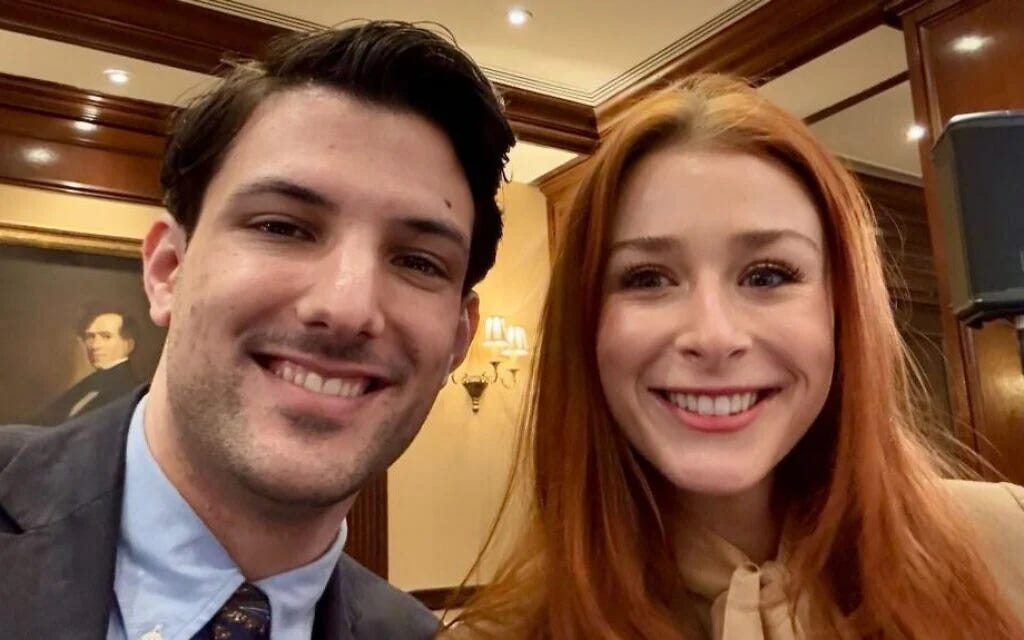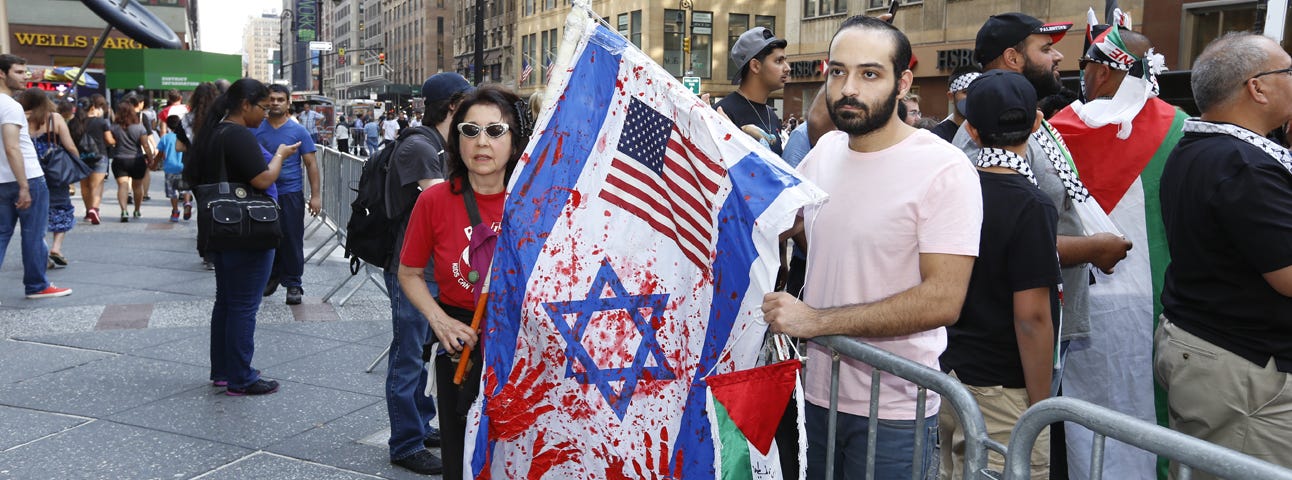The Invented Jew and the Real Bullet
“If the Jew did not exist, the Antisemite would invent him.”
“If the Jew did not exist, the Antisemite would invent him.”
This particular insight from the French existentialist Jean Paul Sartre takes on a haunting relevance these days, especially in the bleak aftermath of the murder of Yaron Lischinsky and Sarah Milgrim in Washington, D.C. Their killer, Elias Rodriguez, didn’t shoot them because they were Jewish. He shot them because he thought they were Jewish, and what they represented.
Yaron Lischinsky and Sarah Milgrim were peace-loving people focused on dialogue and bridge-building. They pursued their diplomatic work at the Israeli Embassy with glowing smiles, compassion, composure and humble confidence. Each challenge they faced was addressed mindfully, wisely and constructively, with an eye on the collective good and the pursuit of truth. Their intention to preserve democratic ideals, free society, and love for life superseded all else. They embodied the core Zionist values of personal responsibility and perseverance, building up rather than tearing down—the ultimate form of construction.
Rodriguez did not kill this beautiful couple in spite of their values, but because of them. His messages and online posts reveal a deeply disturbed worldview shaped by anti-Zionist libels and radical ideology—expressing a hatred for “white people,” accusing Israel of genocide, and romanticizing death. His virulent antisemitism, wish for Israel’s destruction, and admiration for Aaron Bushnell—who self-immolated outside the Israeli embassy in D.C.—make this clear. Rodriguez had been indoctrinated into a warped vision of social justice that framed violence as virtue. He was affiliated with Unity of Fields, formerly Palestine Action U.S., a group that openly supports Hamas’s death cult.
The Anti-Defamation League notes that Unity of Fields is a “direct action network” that “engages in and promotes aggressive, targeted protests and the defacement of property belonging to Jewish and non-Jewish organizations and individuals it considers supportive of Israel or Zionism or ‘complicit’ in Israel’s alleged actions.”
To Rodriguez, “the Jew” was not a person, but a symbol—an invention onto which he projected extremism and hatred. His radical ideology and fury is what pulled the trigger on my dear friend Yaron Lischinsky, a German-born Messianic Christian who made aliyah, and his American Jewish girlfriend Sarah Milgrim. This lovely couple, in the prime of their lives, were targets not for who they were, but for what they represented in the eyes of a man consumed by hateful dogma.
By some token of warped imagination, Rodriguez believed that taking the lives of attendees of an American Jewish Committee (AJC) event about importing humanitarian aid to Gaza and Syria would help alleviate the Palestinian crisis. This is the very delusion of the “Free Palestine movement:” First name-calling, then harassing, and now murdering the innocent in the name of Gaza does nothing to help Palestinians; it only harms.
The Washington Post’s reporting on the tragedy included the subheadline, “The killings of two Israeli Embassy staffers amplify the confusion felt since the Oct. 7, 2023, attacks about where Jews belong.” That assessment is misguided. The killings of two Israeli Embassy staffers in the United States do not amplify “confusion”—they sharpen the clarity that American and global Jewry must fundamentally reassess what they define as antisemitism.
Instead of concocting a politicized assessment of these events in the press, why not ask proponents of the “Free Palestine” revolution exactly what their movement is all about? Why not ask what their slogan means, if those promoting the “intifada” in the name of justice have been proven to slander and now kill people in America thousands of miles away from the war? Due diligence would find that there is nothing to be “confused” about. This was a cold-blooded murder tantamount to those of Hamas or ISIS, targeting democracy, moderation, and the very core of Jewish identity.
Today, antisemitism is commonly standardized under the 2016 International Holocaust Remembrance Alliance (IHRA) Working Definition of Antisemitism, which has been adopted by various organizations and in various countries. However, controversy over its eleven points that serve as tools for identifying antisemitism led to the creation of the 2020 Jerusalem Declaration on Antisemitism (JDA) and others. The nuances of these definitions may be significant, but are immaterial for the purposes of this article.
That is because antisemitism needs no belaboring through such definitions any longer, nor should it be controversial. Movements under the banner of “Free Palestine” and “Globalize the Intifada” have exposed antisemitism as a deeply embedded, chimerical, shapeshifting force that now poses a direct threat to national security.
Long before any of these definitions were conceived, Russian-Polish Jewish physician Leon Pinsker correctly assessed the roots and manifestations of anti-Jewish hatred. In his 1882 essay “Auto–Emancipation,” Pinsker described animus toward Jews as “Judeophobia.” He defined it as a “psychic aberration,” a “fear of the [Jewish] ghost,” and a condition that “suffers the most excruciating pain from the wounds inflicted upon it by the fearful mob who imagine it threatens them.”
Pinsker argued that Judeophobia was a chronic social disease—irrational, deeply ingrained, and millennia old. Understanding antisemitism as a modern expression of this enduring pathology reframes it not just as historical prejudice, but as a recurring symptom of societal dysfunction that mutates with time and resists attempted cures with a new mask.
The onset of ancient polemics about Jews in Egypt or Rome set the precedent for illusions about Jews to take hold and gave future myths legitimacy. Such myths led to the belief that Jews, real or imagined, were the ultimate impediment to redemption. Today, that notion is enveloped in a new fabric. Jewish identity and Israel are cast as the ultimate barrier to liberation. Yet the irony is stark: those who claim to stand for freedom and justice while aligning with Hamas ignore that Israel—like Yaron and Sarah—embodies the very ideals of freedom and justice they seek and claim to uphold.
The scale of delusion and projection is not only hypocritical but alarmingly conspicuous. How did we get here?
We live in a time increasingly shaped by identity politics and mental health crises. Our democratic ideals have been taken for granted, and we have let tolerance go too far. Radical ideologues—whether right-wing nationalists, far-left, or Islamists—have exploited these societal fractures and our Western freedoms to undermine our fragile liberal order.
Rodriguez and many others indoctrinated by academics, social media, or civil society organizations are ultimately united by a hatred toward Jews. Their projections onto the Jewish community and faith are a source of distraction and catharsis. Devoid of all reason, they exhibit a deep mistrust in themselves as they fail to constructively advocate for causes that they purport to champion.
Jews today are being targeted not for what they’ve done, but for what they symbolize to those who no longer discern truth from lies, construction from destruction, and reason from ideological delusion.
Sartre may have held many controversial views, but about this, he was right. The antisemite does not require a real Jew—only the idea of one. In a society losing its grip on moral clarity and truth, the perverted idea to “free Palestine” by killing Jews abroad is all it takes to carry out and justify murder.
If we truly value the classical liberal principles that underpin free societies, we must follow in the steps of Yaron and Sarah’s efforts to preserve them. Rodriguez’s chimerical image of the Jewish community, faith, and national home is libelous. This is why truth must prevail above all, and why the extremist antisemitism exhibited by radicals on college campuses or those like Rodriguez can no longer be treated as a controversial idea. Movements calling for “globalizing the intifada” should be taken at their word, unambiguously condemned, and confronted just as terrorism would.
This article was published in the Jewish Journal on June 3, 2025.




